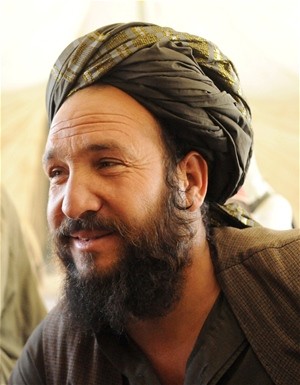
Wakil Tawoos Khan is one of the many internally displaced persons at Camp Hilmand who were grateful for a recent food distribution from USAID’s Badam Bagh Demonstration Farm.
USAID/ASAP
USAID provides Badam Bagh Farm’s fresh produce to internally displaced persons in Kabul.
19 OCTOBER 2009 | KABUL, AFGHANISTAN
Camp Hilmand is a sprawling tent-city located on the southwestern outskirts of Kabul, Afghanistan, and is now home to thousands of Afghans forced from their home villages by violence. One year has passed since Tawoos Khan arrived in the camp from his native Hilmand province. Khan is Camp Hilmand’s wakil (head), representing the roughly 5,000 internally displaced persons with whom he lives. The United States is committed to helping internal refugees by providing food and other forms of humanitarian assistance.
On August 31, 2009, USAID distributed food to the camp, including 12.5 metric tons of watermelon, eggplant, and broccoli, and 16,000 pieces of sweet corn and cucumber. The fresh produce was grown at the USAID-supported Badam Bagh Demonstration Farm. The farm exposes Afghan farmers, governmental staff, and university students to modern agricultural practices and equipment, which they can use to increase the quantity and quality of crops across the country.
Badam Bagh staff distributed produce to all 1,100 families living in Camp Hilmand. The fresh fruit and vegetables were a welcome surprise to the residents, who largely depend upon a few local traders who occasionally provide bags of flour and other essentials.
“We need sustainable help from our government and other relief organizations. These fruits and vegetables that you have brought here are very helpful in our daily lives, and they make our diet healthier,” Khan said.
USAID has a partnership with the National Organization for Women (NOW) that allows Afghan women in NOW’s network of NGOs to harvest and sell the produce grown at Badam Bagh. Beyond sellable produce, NOW has the potential to coordinate the distribution of produce to beneficiaries like orphans and internally displaced persons living in Camp Hilmand.
“When I saw all the happy children, and men and women, I thought that today was the beginning of Eid-ul-Adha,” said one refugee, referring to a major Muslim holiday that is celebrated with much food and joy. “Thank you for your help, and we thank you again if you can provide more help in the future.” With the bounty grown at Badam Bagh and distribution networks in place, USAID will continue assisting the most vulnerable of Afghans.







Comment
Make a general inquiry or suggest an improvement.